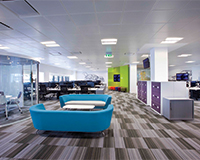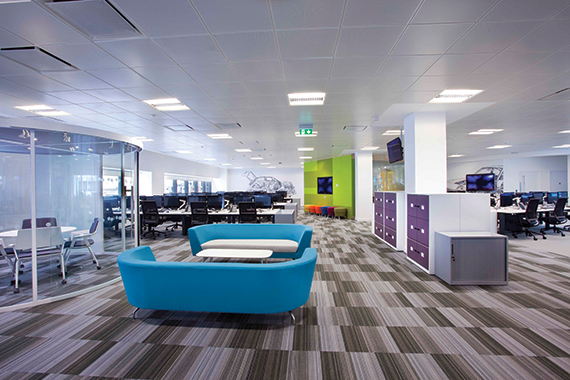Manchester city centre office market had a stellar 2014. The Manchester office agency forum said take-up in 2014 reached 1.3m sq ft, a 53% increase on 2013 and just 295 sq ft lower than the highest figure recorded so far, in 2001.
While the sub-10,000 sq ft market accounted for 76% of the total take-up, inward investment accounted for 16.8% of 319 transactions, more than double the 8% inward movers represented in 2013.
It’s all good news, but the question remains whether this is the market reaching a peak for this cycle or whether there is more to come.
From a planning side the signs are of a slightly cooling appetite. EGi planning research reveals that applications for business space in Manchester were down by 14% in 2014 on the previous year. Perhaps the development pipeline is what is causing a rethink?
Agents expect existing grade-A accommodation to be absorbed throughout 2015, but overall take-up to fall – due in part to a lack of availability. DTZ expects take-up to reach 1.1m sq ft in 2015, more in line with the five-year average. But falling availability is expected to push up rents.
CBRE and DTZ are forecasting headline rents of £33 per sq ft for grade-A space by the end of 2015, up from £32.50 per sq ft a year ago. “Headline rents are on the up,” says DTZ’s Rob Yates.
He adds: “DLA took space in 1 St Peter’s Square at £30-£31 per sq ft. M&G has bought 3 Hardman Square and is quoting £33 per sq ft. Allied London will be quoting £35 per sq ft on 1 Spinningfields.”
CBRE’s John Ogden says rising headline rents do not tell the full story. “Manchester has always had strong headline rents, but we’ve also been giving away some pretty generous rent-free periods, so net effective rents have never been super-strong, and are similar to Leeds and Birmingham,” he says.
“That’s not necessarily the case now. We saw a reduction in rent-free periods in 2014 and will continue to see rent-free periods reduce in 2015 and 2016. A straight 10-year lease grade-A in the city centre shouldn’t expect more than 24 months and more like 18 months, as there’s not a lot of good quality stock there.”
Not for the time being anyway. With 1 St Peter’s Square completed and still with 140,000 sq ft available; Mosley Street Ventures’ 161,113 sq ft 2 St Peter’s Square under way, on the back of partial prelet to Ernst & Young; Allied London on-site with Cotton House at Spinningfields, prompted by a prelet to Shoesmiths, plus Tristan Capital’s partnership with ASK at 101 The Embankment, One New Bailey, Manchester has no shortage of new development.
Perhaps too much, says Savill’s James Evans. “My concern is two years ago we had one building coming out of the ground in the form of 1 St Peter’s Square and that’s now completed. Then we had a pregnant pause where we could have six buildings delivered within 12-18 months. That’s getting towards unsustainable. It feels like maybe one building too many.”
“I suspect we won’t see any other major schemes kick off speculatively in the CBD in the next 12 months,” says Canning O’Neill’s Conrad O’Neill.
So, with 600,000 sq ft of prime grade-A space being built in the city centre and another 400,000 sq ft expected to start on site this year, the next development cycle in the city appears to have been all but fulfilled. Yet while the cranes have gone up in the city centre, the next building completed to grade A will not be ready until May 2016: MUSE Developments’ 120,000 sq ft One New Bailey.
This leaves developers without oven-ready schemes, anticipating when this next wave will be absorbed and when will be the best time to deliver product. More than 400,000 sq ft of grade-A space was absorbed last year and the supply of office space is diminishing, leaving an immediate position of undersupply.
This lack of immediately available grade-A schemes will mean developers’ appetite for refurbished properties such as Manchester Royal Exchange, Fountain Court and 81 Fountain Street will be stronger, as rents rise and incentives come in, making these schemes much more viable (see below).
Manchester’s attraction to inward investors and its strong financial and professional services sector should stand it in good stead, but perhaps the window of opportunity for new build might have been reached for the time being.
A good return on refurb?
Savills’ James Evans says the difference between top rents and average grade B is around £16-18 per sq ft – the historic norm is more like £13 per sq ft and was £10 per sq ft 10 years ago.
“This is too big a gap,” he says. “The mid-tier range is priced slightly low and, given the existing demand, I see some real opportunities in the refurb market for landlords to see some rental growth.
“When one considers the success Bruntwood has had in letting its portfolio, which now has very limited void, and the activity at schemes such as Aberdeen’s Acresfield, USS’s The Observatory and IVG’s 35 Fountain Street, it is evident this sector of the market, as businesses continue to recover, will see a reversion of tenant demand towards the good-quality refurb market at £20-25 per sq ft, something that is scarce in the market at present.”
Speed to market for such schemes is critical to take advantage of the current paucity of stock, says GVA Manchester’s Chris Cheap. “Manchester is at risk of going from famine to feast very quickly within both prime and secondary. Attention to detail in design and delivery will be critical to new and refurbished schemes, performing or not. But landlords and developers need to take care to provide a refurbished product comparable in specification to new space and that is future-proofed from the trajectory of green legislation.”
Differentiation seems to be the key with grade-B space, so schemes such as Acresfield are becoming fully let while more standard space remains vacant.
It’s all about comfort with refurbs, says Capital Properties’ Mark Burgess. “The style has changed dramatically in the past five years. Boardrooms have sofas instead of mahogany tables. Nobody needs to be in an office anymore, so employers need to make their offices more enticing so people want to spend time there. It’s not about cool, but comfort and collaboration.”












